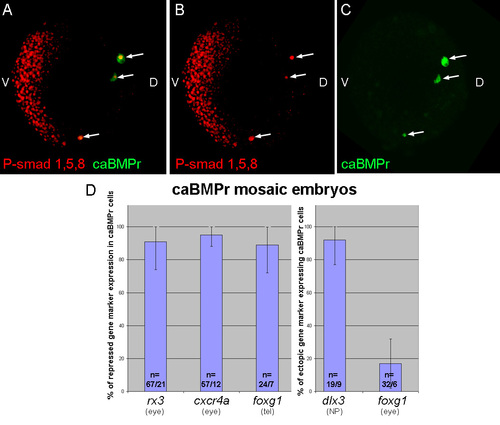FIGURE
Fig. s4
- ID
- ZDB-FIG-130104-3
- Publication
- Bielen et al., 2012 - BMP Signaling Protects Telencephalic Fate by Repressing Eye Identity and Its Cxcr4-Dependent Morphogenesis
- Other Figures
- All Figure Page
- Back to All Figure Page
Fig. s4
|
High levels of Psmad1,5,8 are induced cell autonomously in caBMPr transgenic cells causing robust changes of neural marker expression (A-C) Animal view of a mid gastrula caBMPr mosaic embryo stained for P-smad1,5,8 in red, shield to the right. Arrows point to single caBMPr-transgenic cells (green cells) in the dorsal half of the embryo which ectopically induce nuclear P-smad1,5,8 (red) in a cell autonomous manner. (D) Statistical analysis of repressed and induced gene expression in caBMPr cells, respectively. n=number of cells/ number of embryos. (tel, telencephalon; NP, neural plate). |
Expression Data
Expression Detail
Antibody Labeling
Phenotype Data
Phenotype Detail
Acknowledgments
This image is the copyrighted work of the attributed author or publisher, and
ZFIN has permission only to display this image to its users.
Additional permissions should be obtained from the applicable author or publisher of the image.
Reprinted from Developmental Cell, 23(4), Bielen, H., and Houart, C., BMP Signaling Protects Telencephalic Fate by Repressing Eye Identity and Its Cxcr4-Dependent Morphogenesis, 812-822, Copyright (2012) with permission from Elsevier. Full text @ Dev. Cell

